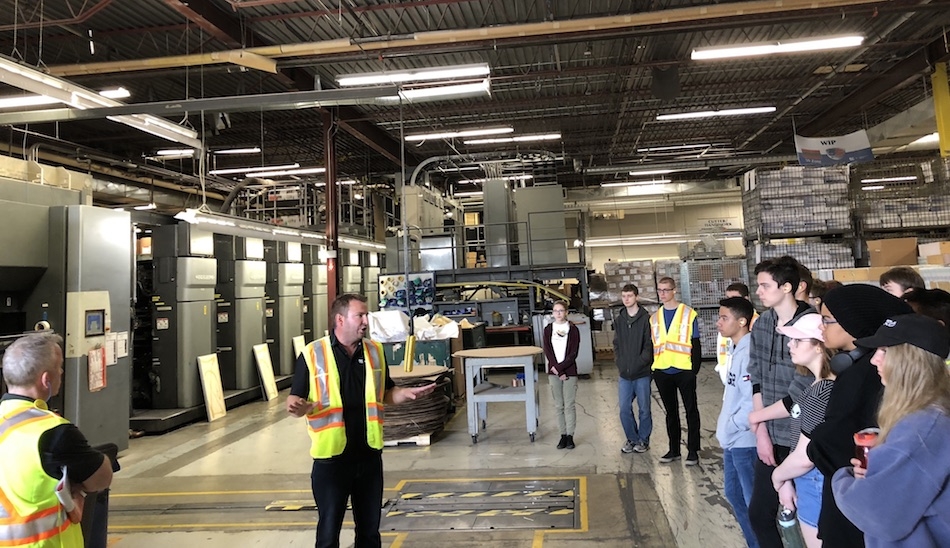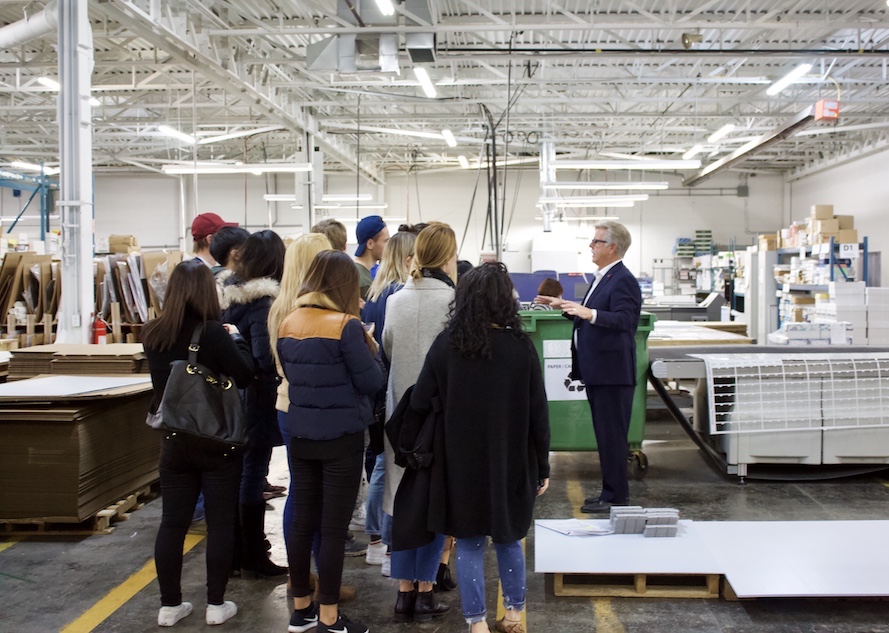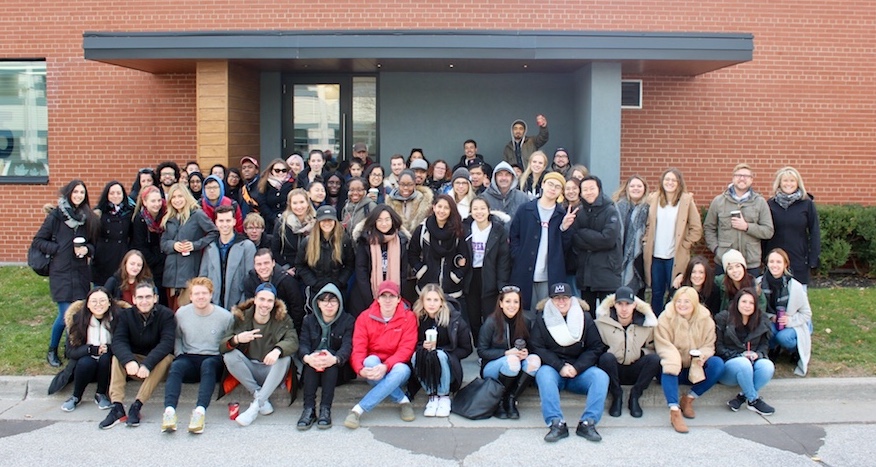
Features
Business
Training
Reaching our youth
Print leaders share their strategies for recruiting and hiring the next generation
December 17, 2018 By Victoria Gaitskell
 Winnipeg’s Westwood Collegiate tours TC Transcontinental Printing. Photo: Manitoba Print Industry Association
Winnipeg’s Westwood Collegiate tours TC Transcontinental Printing. Photo: Manitoba Print Industry AssociationGeography has made Friesens, one of North America’s leading book, yearbook and packaging manufacturers, especially creative at recruiting new candidates for the printing workforce.
The company is situated in the town of Altona, Man., (population 4,212), 100 km south of the provincial capital of Winnipeg and 10 km north of the U.S. border. Although this location helps foster the company’s cross-border trade (about 50 percent of its book and 20 percent of its yearbook production enters the U.S. market), it also creates challenges for finding staff in the town and surrounding rural municipality of Rhineland, an area largely devoted to farming and agriculture-based business.
Dana Bergman, Friesens’ Training Coordinator, says the company’s local staff totals about 500, not including the 100 sales representatives scattered across North America. “Because of where we’re located we struggle with getting skilled workers, so we train up a lot of our own workers who start in entry-level positions. Right now, if the right individuals walked through the door, we would probably hire 15 to 20 more people,” she says.


In November 2018, Mi5 Print & Digital hosted 75+ Humber College students for a tech tour of its Mississauga, Ont., facility. The tour included a walk-through of the litho, web, digital, large-format and in-house bindery departments and a look at file preparation and prepress planning and proofing. Photos: Mi5 Print & Digital
Hands-on experience
One way Friesens cultivates potential new hires is by providing openings for the local high school’s Career Internship Program. This program helps Grade 11 and 12 students gain both academic credit and employability by spending 75 hours in the workforce in a field of their choice. Bergman explains these high school internships are unpaid and at Friesens occur mostly in production areas in the pressroom or bindery.
“We work with the school to assess the students’ interest and mechanical skills and whether they are a good fit for our environment…and some we have been able to give on-the-job technical training and employment after graduation. One IT student who went on to full-time employment here is now one of our intermediate software developers.”
Friesens annually hires two to five students on mandatory unpaid eight-week practicums from the Manitoba Institute of Trades and Technology (MITT)’s Graphic and Print Technician Program in Winnipeg, Man.
Kevin Gregg, Internship Coordinator for Ryerson University’s Graphic Communications Management (GCM) in Toronto, Ont., oversees about 130 four-month internships a year. The support both Ryerson and MITT students receive to find a job for their internship includes a job fair where students attend a series of 10-minute ‘get acquainted’ interviews with a variety of prospective employers in a process akin to speed dating. Gregg says the job fair often leads to internships and part-time jobs while in about 40 percent of cases, students complete their remaining studies and take on full-time jobs.
Gregg continues: “Although larger printing companies may take three or four interns at a time, we place no size requirements for companies that provide internships. One student from Gravenhurst [Ontario], whose hometown printer wasn’t hiring, successfully convinced the owner to give him an internship and the situation worked out really well on both sides. If a smaller printer has difficulty providing the prerequisite full job description for the intern, I have no problem phoning the employer to clarify things.”
Based in Toronto, Ont., Eva’s Phoenix Print Shop – operated by Eva’s Initiatives For Homeless Youth – is a commercial printer and social enterprise that trains young people experiencing and at risk of homelessness. Through a seven/eight-week training program, the students are introduced to the pillars of the industry and learn digital printing, bindery, large-format printing, prepress and design fundamentals using Adobe Creative Suite, as well as job readiness training such as workplace expectations and effective communication skills.
To further the program, Eva’s Phoenix Print Shop has announced that starting next February, its eligible cohort of eight graduates will be ready to fill work placements and potential employers who take on the job-ready candidates will be able to receive up to 11 weeks of paid subsidized work placement – equating to potentially $5,000 in wage subsidies – from Eva’s Print Training Program.
Related: Eva’s Phoenix named top pick charity
Scholarships and financial aid
Friesens provides post-secondary education scholarships to children of staff members as well as post-secondary students who have returned to the company after working at least one summer there. Also in the works is a new plan for tuition reimbursement to support post-secondary learning for students in positions for which they have a high need, including estimating, customer project management, and press and bindery operators. “We’re looking to engage with Grade 12 students before they graduate by saying, ‘If you are interested in any of these fields, we will support your education, build in paid periods of work between school years and enter into a post-graduation contract with you,’” Bergman says. “Sponsoring students while they work here helps us attract and retain local talent.”
Hiring challenges
“Without printing there would be no food, no soap, no shampoo, no toilet paper — there’s nothing sold,” Warren Werbitt, Founder of Pazazz in Montreal, Que., says. “Everybody in the world needs us yet nobody likes us. The bottom line is the industry is not a sexy business, so how are we supposed to get young people in?”
Barry Miller is Executive Director of the Manitoba Print Industry Association (MPIA), an 85-percent provincially funded non-profit organization focused on attracting and retaining individuals in the industry. He recounts: “Historically Winnipeg’s geographic location in the centre of Canada has been favourable for print and is home to companies like Pollard Banknote, Duha and Color Ad Packaging. Yet if I’m at a career fair and I ask students to name one local company that prints, most of them can’t even come up with the Winnipeg Free Press.
“Often times employers can’t find a bindery worker or press operator in Winnipeg because any who exist are already working or retired. Especially with retirement and people moving up in their companies, who will fill those entry-level jobs? We are trying to help people realize the opportunities that are available.”
Besides public education, MPIA’s other services include training opportunities, professional awards, and a scholarship program for printing and/or graphic design students. Elisa Solomon, the association’s second staff person, serves as Career and Human Resource Consultant, primarily for small companies without a human resources capacity, providing such assistance as consultations, screening resumes, hiring interviews, policies, records and performance management.
Barry Miller, Executive Director, and Elisa Solomon, Career and Human Resource Consultant, Manitoba Print Industry Association. Photo: MPIA
Related: Mi5 hosts tech tour for Humber students
School tours and talks
Throughout the year, Friesens engages youth and the public by hosting tours for MITT and other organizations, including schools that print their yearbooks with Friesens. As well, high school electrical technology and robotics classes from a neighbouring town have also visited Friesens to learn how their subjects apply to the print industry.
For 25 years, Friesens has also held a week-long summer day camp free of charge for 9-to-11-year-old children of staff members where the variety of activities offered to campers includes participating in the content creation, design and production of a book.
Related: Engaging with millennials through direct mail
Werbitt, who created Printing’s Alive and other popular YouTube videos in which he enthuses about print, says a first-year Ryerson GCM student emailed him in October to ask if she could visit his plant. He invited her to come any time, and when she arrived for a tour, he spent an hour and a half showing her around. She later told Werbitt he was the only one out of five printers who responded to her request. “Oh my God, how wrong is that? How do we not encourage the young people?”
He continues: “In 2016 I was speaking at an Idealliance conference, and when I was up at the podium, I looked around and said, ‘Where are all the young people? Why are all you old people here? Most of you aren’t happy with the business. You’re going to go back, and you’re not going to bring any value. You can’t tell me you can’t afford to bring some young people to these shows. Enlighten them, empower them, make them feel special. When they get back, they’ll spread the word about what they’ve heard.’”
This article was originally published in the December 2018 issue of PrintAction, now available online.
Print this page